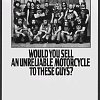The motorcycle industry in both the United States and Europe has barely recovered from the recession of 2008, but there is still one place in the developed world where motorcycles are as popular as ever: In the ad industry.
You may not know this about me, but I’m a reformed copywriter and creative director. I spent decades at ad agencies in Canada and the states before switching to motorcycle journalism. My Facebook friends, and Twitter, still feed me creative commercials — one of which recently reminded me that I’ve seen lots of great ads with motorcycles, but no great ads for motorcycles.
Any Belgian catching this spot on TV would know that the monks of Leffe Abbey began brewing beer in the Middle Ages. For centuries, the monks traditionally welcomed any and all pilgrims, providing accommodation and sustenance, including beer. (That goes without saying in Belgium.)
Ad agencies inject motorcycles into ads for everything from cars to cosmetics, because bikes are visual shorthand for badassness (if that’s a word). Creative directors, copywriters, and art directors, tasked with making their clients’ products seem cooler than they really are, know that just showing them in association with a motorcycle makes them sexier.
In the United States, the Super Bowl is not just the biggest football game and most-watched television event, it is also basically the Super Bowl of advertising: The most expensive commercial time, filled with the most-watched commercials. For years, I wasted my breath bemoaning the fact that no motorcycle company had the confidence or commitment to advertise in the big game. But motorcycles have made plenty of cameo appearances.
Last year, when Squarespace bought time in the Super Bowl, it could have highlighted any of the millions of small businesses with Squarespace websites. It chose Keanu Reeves’ Arch Motorcycles company.
That ad held its own in Super Bowl LII, but I’m not sure that Squarespace really did motorcycling any favors with Mr. Reeves’ bike-surfing.
The highest production-value spot I can think of, for motorcycles, was Keira Knightly’s epic commercial — almost a short film — for Ducati back in 2011.
What’s that you say? It’s not a motorcycle ad? It’s an ad for perfume? Whatever. The motorcycle industry is desperate to attract more female riders. With 10 million views on YouTube and counting, Chanel’s probably done more for the cause than the MIC ever will.
Around the same time that Chanel made me re-write my Last Will and Testament (I amended it to read, “When I die, please tan my hide and use it to make Kiera Knightley’s next set of leathers”) T-Mobile also launched a series of commercials that might as well have been motorcycle ads.
Again, it was Ducati that got the love, as Toronto model Carly Foulkes appeared in several commercials riding an 1198. The first spots just used the Ducati as a general allegory for speed and technology, but later on they used motorcycles to illustrate the relative speed of T-Mobile’s 4G network versus its rivals.
Come to think of it, I guess that other motorcycle represents the network I’m on.
The fashion world also loves to appropriate motorcycles. Two years ago during New York Fashion Week, Rihanna — who has a fashion line in collaboration with Fenty and Puma — showed bodysuits modeled on race leathers, while FMX stunt riders flew over the catwalk. And the high-fashion label Chloé recently showed an entire line of blouses and leather jeans inspired by Anne-France Dautheville, a breathtaking French beauty who explored Africa, the Middle East, and Central Asia by motorcycle in the 1970s.
There’s another advertising industry angle here. Dautheville worked in an advertising agency in Paris before she quit to go explore the world by motorcycle. She rode almost continuously for a decade beginning in 1971 and supported herself by selling stories to French motorcycle magazines and writing books about her travels, including "Une Demoiselle sur une Moto" (Girl on a Motorcycle, 1973) and "Et J'ai Suivi le Vent" (And I Followed the Wind, 1975.)
Maybe there’s some deeper emotional bond between the ad industry and motorcycling. The legendary copywriter David Ogilvy started an eponymous ad agency. Ogilvy’s Taiwan-based creative team (Creative Director Jennifer Hu, Copywriter Justin Chia, and Art Director Leah Chen) utterly nailed this spot, titled "Dream Rangers." For my money, this is the best ad ever made for motorcycling. Except, it’s not an ad for motorcycles at all; Ogilvy Taiwan’s client was TC Bank.
I realize that the last thing the motorcycle industry needs to attract is more old guys. That’s our problem, too many of us are too old. But Ogilvy captured one of the great truths of our sport, which is this: If motorcycles don’t kill us, they keep us young. If you don’t love this commercial, you don’t have a soul.
So when will we see great ads like this for motorcycles?
I’m not going to make any friends by saying this, but the last really effective American TV commercial for a motorcycle company was probably the first one: Grey Advertising’s “You meet the nicest people on a Honda” campaign, which broke way back in 1964. Lemmy just revisited that campaign in his disquisition on Honda’s new Monkey.
Lemmy is right: We need another "nicest people" moment. We need a big idea, boldly executed, to make a million people think, “I could do that.” For all the disruption in the ad industry — targeted digital advertising, social media, pop-up experiences, whatever — television remains the best medium to inspire consumers in that way.
But here’s an irksome irony: Motorcycles are used in other ads for beer, banks, or perfume because motorcycles = risk, motorcycles = daring, motorcycles = adventure in the minds of the general public. Unfortunately, the motorcycle industry itself is very conservative.
So, one thing holding us back from our next "nicest people" moment is, as Lemmy noted, the fact that few to no contemporary moto executives have the ’nads to write a check big enough to shift a million opinions. And no one is going to grow a pair, because the ads we currently make aren’t good enough to generate results that would, over time, give our execs the courage of their convictions.
Over my years in the ad business, one thing I learned the hard way is that almost all TV ads are destined to suck before the creative team pulls its first all-nighter. It’s not just — or even mainly — a case of clients being too cheap. Ad suckage is a foregone conclusion when clients can’t decide which product to focus on, or when they use film — a great medium to convey emotion — to convey facts (“Get 1.9 percent financing for a limited time during Yamazuka Days.”)

I guarantee you that the people who worked on the "nicest people" campaign at Grey Advertising in 1964 weren’t a bunch of ex-OEM and magazine staffers who moved to advertising after some previous industry contraction. In fact, one reason the campaign succeeded was that most of the people working on that campaign were the target: non-riders who could be convinced.
Don’t get me wrong; I haven’t completely given up hope. I think there’s a chance that someone will at least try to create the next "nicest people" moment. If I had to guess who’ll write the check, I’d guess Matt Levatich at Harley-Davidson. He’s made it the company's mantra that Harley's job is to build riders, not just build motorcycles, and he’s green-lit the most striking set of new models in the company’s modern history.
Whether it’s Levatich or someone else, I hope they remember one thing from this essay: Watch that Leffe beer ad again, and that TC Bank ad again, and remember that all great ads tell stories. Clients outside the moto industry are telling funny, sexy, heart-warming stories with motorcycles in them.
It’s time for us to do that, too.








